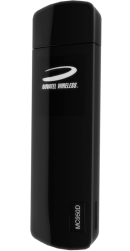Other
Archive for March, 2008
Business costs highest in Vancouver
Friday, March 28th, 2008KPMG study says Canada leads the way among G7 nations
Paul Luke
Province
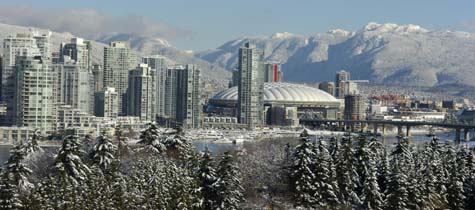
Housing affordability is ‘challenging’ in Vancouver, but B.C.’s metropolis rates well in other areas. Photograph by : Les Bazso file photo – The Province
Vancouver remains Canada‘s costliest city in which to do business, a new study shows.
And if that dubious honour isn’t enough, the declining U.S. dollar has eaten into the city’s previous cost advantage in the Pacific Northwest, according to the KPMG study released yesterday.
The study, which is done every two years, measured 27 business costs in 136 cities across 10 countries.
Vancouver‘s overall cost advantage over Seattle has been whittled down to “a minor 1.3-point lead,” KPMG said.
Housing affordability is challenging in B.C. but the province’s cities rate well on other factors, the study found.
“Although the high Canadian dollar does present challenges, British Columbia enjoys a strong economy with low unemployment, a highly educated workforce including foreign-born professionals and strong GDP growth,” said Elio Luongo, KPMG’s Vancouver managing partner.
Chilliwack is Canada‘s third-most-expensive city in which to do business and Calgary placed second.
Canada maintained its ranking as the world’s second most cost-competitive country to do business in as tax cuts offset some of the impact of the rising loonie, the study found.
Canada ranked only behind Mexico, which was included in KPMG’s Competitive Alternatives study for the first time this year.
The cost of doing business in Mexico is about 20.5-per-cent cheaper than in the United States, which is used as the benchmark indicator for the study.
Of the G7 group of countries, Canada now leads the way, followed closely by the U.S.
The study found the weaker U.S. dollar had helped the U.S. move up four places to rank third, followed by Australia, which previously ranked first. While Canada retained its second spot, the figures showed its cost-competitive edge had narrowed to less than one per cent with these two countries.
France was in fifth spot, followed by the United Kingdom, the Netherlands and Italy. Japan and Germany were at the end of the list as the least cost-competitive places for business.
“With the Canadian dollar at par, Canada is challenged to maintain the competitive edge it once held,” said Mark MacDonald, global director, competitive alternatives at KPMG.
“Canada has to present a clear value proposition to businesses in other areas. One example of this is the federal government’s recent cuts to corporate income tax rates, which are among the lowest for a wide range of operations among countries surveyed.”
Glenn Mair, a co-author in the study from MMK Consulting, said Canada also ranks highly in terms of non-cost factors, such as education. “Canada consistently ranks well when we consider environmental regulation, education attainment, housing affordability, labour force, and energy availability — all of which are important business-location considerations,” Mair said.
The survey found that among major Canadian cities, Montreal and Halifax had the greatest cost advantage relative to comparable U.S. cities.
It found business costs had risen the fastest in British Columbia and Alberta over the past two years, reflecting the western economic boom. Vancouver was still the country’s most expensive city, followed by Calgary and Chilliwack, then Toronto.
The study measured 27 significant cost components that are most likely to vary by location, including labour, taxes, real estate, and utilities, as they are applied to 17 business operations, over a 10-year planning horizon.
© The Vancouver Province 2008
Cost of business rises in Vancouver
Friday, March 28th, 2008It’s the most expensive city in Canada, according to KPMG study
Bruce Constantineau
Sun
High real estate values have bolstered Vancouver‘s position as the most expensive Canadian city in which to conduct business, according to a KPMG study.
The study — which examines 27 cost components and assigns a value of 100 to average costs in the U.S. — said Vancouver‘s cost index has risen from 96.9 to 104.2 in the past two years.
Calgary is the second-most expensive Canadian business city, with an index that has risen from 94.7 to 102, while Chilliwack is third, with an index that has gone from 94 to 101.6.
MMK Consulting representative Glenn Mair, an author of the study, said high house prices and other real estate values continue to drive up business costs in Vancouver.
“Industrial property costs, construction costs and office leasing costs are all quite high in Vancouver as a result,” he said.
Mair said Chilliwack‘s proximity to Vancouver has clearly driven up business costs in that Fraser Valley community, which also faces high real estate values and labour shortages that have driven up wages.
The study noted the strong Canadian dollar has taken away much of the business cost advantage Vancouver used to enjoy over Seattle. Vancouver‘s cost index is just 1.3 points lower than Seattle‘s but in 2006, it was 7.5 points lower.
“The strong increase in the Canadian dollar has really closed the gap in business costs between Canada and the U.S.,” Mair said. “But even with the dollar at par, Canada can still be competitive with the U.S. because of some significant cost-competitive changes that have occurred in the past decade.”
He noted federal and provincial cuts to corporate income taxes across Canada have been a major boost to businesses throughout the country.
The study said Canada (99.4), the U.S. (100) and Australia (100.2) are the business cost leaders among nine developed countries surveyed. Mexico, an emerging industrial country, had a business cost index of just 79.5 — the lowest of 10 countries examined in the study.
Mexican labour costs were the lowest by a wide margin but Canada ranked much higher than Mexico on quality-of-life issues like health care, crime rates and education.
Germany (116.8), Japan (114.3) and Italy (107.9) had the three highest national business cost ratings in the study. The three countries face the added challenge of having the oldest populations — having the largest proportion of citizens older than 44 and the smallest proportion under 25.
© The Vancouver Sun 2008
Radha’s mantra is simplicity
Thursday, March 27th, 2008Chef Andrea Potter gave up fine dining to work at an inexpensive vegan restaurant
Mia Stainsby
Sun
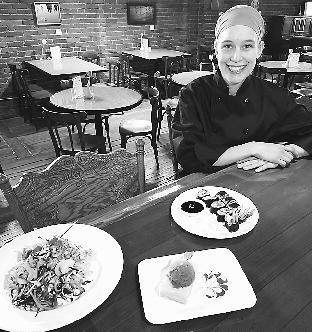
Andrea Potter sits with some dishes. They include grilled kebabs with saffron basmati and marinated carrot (left), radish and sprout salad, and nori roll. Photograph by : Ian Smith, Vancouver Sun
“I was finished with egos in kitchens of fine dining,” Andrea Potter says, explaining why she gave up swank for simplicity and health.
She’s the chef at Radha Yoga and Eatery, an alternative, second-floor vegan restaurant. It’s only open only three evenings a week, from Thursday to Saturday, and it’s a stark contrast to her job in Belfast, Ireland making pastries in a restaurant that until recently, had a Michelin star, meaning it was pretty fabulous.
She moved to Vancouver two years ago and worked as entremetier (preparing veggies) at Feenie’s for about five months before she moved over to Radha. “Fine dining wasn’t jiving with my personal philosophy on food,” she says. At Radha, she shows that vegan food can be interesting. I wasn’t enthralled with all of the dishes but overall, the food is delicious enough to draw me back. Her customers, she says, are omnivores, not just vegans.
She puts huge effort into wringing nutrition out of ingredients. Example: the mushroom and almond ‘ricotta’ napoleon, a layering of crimini mushroom duxelle (a mushroom paste of shallots, herbs) and Fraser Valley almond ‘ricotta’ between sheets of crisp, whole wheat phyllo. For the almond ricotta, she soaks the nuts to activate enzymes (like sprouted seeds) and grinds it into a paste with miso, lemon juice, herbs and sea salt. Fermented ingredients, like the miso, is a running theme in her dishes for its health benefits. It’s a delicious dish befitting of a high-end restaurant.
Some items on the menu are holdovers from Radha’s earlier days when it just served lunch. Regulars didn’t want to part with them. Potter calls them Classics on the menu — the nori roll with raw sunflower and hempseed paté with sprouts, avocado and julienned veggies wrapped in nori; masala yam wedges; a grain bowl with veggies, sprouts, hempseed over brown rice and a choice of sauce; quinoa nut burger, a mile-high burger that comes loaded.
Potter introducing new dishes every month. In February, I had a lovely beet and orange salad and a raw food pizza made with a cashew nut crust; my husband liked his potato blini with eggplant caviar and a polenta lasagne. For dessert, a yummy vanilla almond panna cotta with a strawberry balsamic compote.
She buys as much organic as she can and manages to keep prices very reasonable ($7 for appetizers and $13 for mains). When I visited this month, a couple of dishes didn’t work for me. The roasted garlic cannellini bean ragout with scalloped potatoes and squash gratin was too stodgey and the nori roll was too mushy for my liking. The quinoa burger was big and bodacious but I wasn’t too keen about the raw chocolate banana cream pie with coconut date crust, though — it was too dense for me, but my husband liked it fine.
And guess what? There’s a wine list offering really reasonably priced wines. But I went straight for the kombucha tea, which is fermented with a kombucha colony of yeast cultures. It’s supposed to be very cleansing and besides, believe it or not, Potter makes up a wickedly delicious, light and sassy brew.
– – –
RADHA YOGA AND EATERY
728 Main St., 604-605-0011.
www.radhavancouver.org.
© The Vancouver Sun 2008
A leftover lover’s haven
Thursday, March 27th, 2008Sharing dishes is best
Michelle Hopkins
Sun
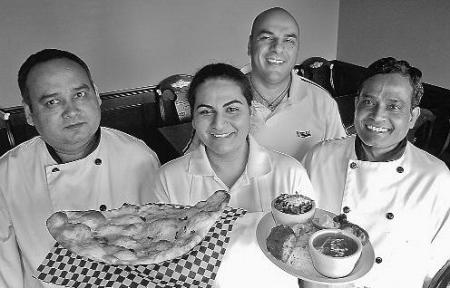
Mahek restaurant’s Harvey Sanghera (rear) with wife and chef, Tara Sanghera, chef Laxman (left) and chef Veerain (right). Photograph by : Bill Keay, Vancouver Sun
Mahek Restaurant & Lounge, on the border of Surrey and Delta, is a restaurant for those who love East Indian cuisine.
We went early on a Sunday evening and the restaurant was half full. By the time we ordered appetizers, the place was filled to the brim, with lively chatter all around us and a line-up at the door.
The polish behind Mahek is obvious in every detail. The décor is a testament to owner Harvey Sanghera’s good taste. The walls are adorned with carved Indian wood-work and a cascading water feature with a lit Mahek sign takes centre stage at the bar. You’ll also noticed this delicate fragrance in the air; it’s infused with a hint of coriander, nutmeg, saffron and other spices you might not recognize.
Servers are friendly and know the menu well. Let them help you select the meal and you won’t be disappointed.
The wine list isn’t long list but you’ll probably find a red or white to suit your palate.
If you favour naan bread, you’ll love the variety here. The breads are fluffy, melt in your mouth and are served with your choice of homemade (secret family recipe) sauces. We opted for the mint chutney and the ‘Papdam‘, which is a red chutney and had to order more; they are refreshingly tangy and, frankly, addictive.
One of the best ways to enjoy Indian cuisine is to order a variety of dishes to share. And that’s just what we did.
The Chicken Tikal Masala ($10.95) is a signature dish, with a surprising onion, tomato gravy. We also ordered the Dhai Balla, ground lentil balls deep fried, dipped in yogurt and served with (yes, more) chutney. ($5.95); prawns Vindallo, in a tangy curry sauce with rare spices (Harvey says it’s a famous fiery Goan specialty and I agree, it’s hot, yet delicious, for $11.95); and finally a few vegetarian selections, the Dal Makahni, lentils cooked with onions and tomatoes ($8.95).
The food is wonderfully flavourful.
The portions are generous, the menu varied and lengthy, and we came home with enough leftovers for two.
Sanghera grew up in England, home to some of the best Indian food.
When he immigrated to Canada a little less than two years ago, he and his wife/chef Tara Sanghera went on the lookout for an Indian restaurant for sale — it was to be his wedding present to Tara.
The couple had dined at Mahek Restaurant & Lounge a few times and were impressed with the food. They approached the owner and seven months later it was theirs.
The Sangheras updated the lighting — it’s soft and creates a warm, cosy ambience — the décor and the menu.
“It already had a very good reputation and we just wanted to put our own stamp on it,” says Sanghera. “Tara is an excellent cook and back home she was constantly asked to cook for family and guests.”
Tara and two seasoned chefs make up the kitchen team.
The prices at Mahek are surprisingly reasonable. The restaurant’s semi-upscale décor suggests a much higher priced menu.
Mahek Restaurant & Lounge is a classy restaurant to eat some well prepared Indian food. One feels an atmosphere of well-being here.
Mahek seats 122 inside. To avoid disappointed, reservations are recommended on the weekends. Phone 604-585-3331 or visit www.mahek.ca.
– – –
MAHEK RESTAURANT & LOUNGE
9470 — 120th St., Surrey
Reservations recommended
604-585-3331
Open: Mon-Thurs 11:30 a.m. to 10 p.m., Friday 11:30 a.m. To 10:30 p.m., Saturday noon to 10:30 p.m., Sunday noon to 10 p.m.
© The Vancouver Sun 2008
Fraiche’s fare outshines great view
Thursday, March 27th, 2008Feel-good atmosphere at the right price
Mia Stainsby
Sun
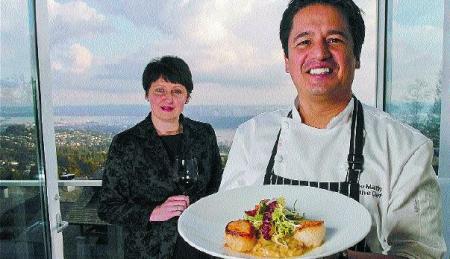
Mary Ann Masney and chef Wayne Martin have opened the Fraiche restaurant in West Vancouver. The restaurant has a beautiful view of downtown Vancouver. Photograph by : Ward Perrin, Vancouver Sun
The breadbasket is a foreshadowing device. If we empty it, it’s a sign of good food to come.
At Fraiche, we gobbled up the bread in no time. Not surprising when you consider the man in the kitchen. Chef and co-owner Wayne Martin also runs Crave, the great-value Canadian bistro on Main Street. Before that, however, he was the big cheese at Four Seasons in Vancouver and at other locations; one does not lead Four Seasons kitchens without being in alpha league of cooks.
Fraiche sits like a crow’s nest on the slopes of upper West Vancouver with a sweeping view of water and city. (Actually, that should be cities, plural, because on a clear day, you can see out to Richmond.) I’m happy that this is more than a place to force march out-of-town guests to gloat about our beautiful city. Just don’t miss out on the food experience. Gloat about it, too.
Co-owner/general manager Mary Ann Masney runs the front with ease and expertise. She’s done the same at Araxi, Bacchus, and Quail’s Gate Winery restaurant. The idea was to offer the community above the Upper Levels a neighbourhood restaurant. To get there, you ascend the mountain, past palaces occupying far too large a carbon footprint than any household deserves and you come upon Fraiche in modern envelope of glass, wood and views. Once inside, you behold a dramatic 400-pound dogfish sculpture by Robert Davidson. Masney is the welcoming committee; she does the rounds, chats and all of a sudden, it’s a feel-good room.
Fraiche is everything the former restaurant, Bread and Tulip, was not. Starters are $8 to $18 (the latter for Quebec foie gras) and mains are $18 to $40 (the latter for butter-poached lobster). The lounge menu will be up and running, offering favourites from Crave that people have asked for — burgers, cobb salad, tuna nicoise — and they can be ordered in the dining room, too.
The food didn’t disappoint. When I first opened the menu, I spied “truffle” on a couple of items and my heart raced. For starters, roasted celery root soup with fine shavings of black Perigord truffle was perhaps a little too thick but quite luscious. Roasted beet root salad was fresh and tasty. Crabcakes were light, full of crab and sat in a wading pool of seafood chowder. Organic chicken noodle soup featured flavourful chicken.
I had the most tender, buttery duck I’ve ever come across and it wasn’t just the magnificence of the duck meat. After rendering it down, stove-top, Martin roasts it in a very slow oven. He cuts it thick but that’s no hindrance to knife or teeth. Arctic char had a golden crust but inside, it was cooked just to the edge of doneness; it was served with bacon and brie ravioli and caramelized onions. Lemon and herb marinated lamb rack proved to be a gorgeous piece of meat and a fresh-made pappardelle with roasted mushrooms and artichokes was light and earthy.
The pastry chef, 24-year-old Amanda Cheng is one to watch. Dessert offerings are limited but I can see she’s very skilled. Her passion fruit chocolate bombe is on a par with a Thomas Haas creation. Did I really say that? Yes. And I’ll stick by it. On our second visit, we didn’t share as we customarily do. We each ordered one and were glad we did.
The “chocolate bar” was like an ingot of chocolate enrobed with ganache as shiny as patent shoes. My lemon tart was luscious, a perfect balance of sweet and sour.
One server was like a Jim Belushi stand-in, with a great sense of comic timing. “Well, in that case, do you want a bottle?” he asked my husband when I declined wine. “You have a designated driver.”
The wine list is limited by space but Masney, who’s the wine director, has been cherry-picking the some favourites from California and France with pepperings of Australia, New Zealand and B.C.
This is one view restaurant where a windowful of water and mountains aren’t the only payoff. It’s worth the trip, even when the view is nothing but grey clouds.
– – –
FRAICHE
Overall: 4
Food: 4
Ambience: 4
Service: 4
2240 Chippendale Rd., West Vancouver. 604-925-7595. www.fraicherestaurant.ca. Open for dinner only. To offer lunch and brunch at later date.
Restaurant visits are conducted anonymously and interviews are done by phone. Restaurants are rated out of five stars. [email protected]
© The Vancouver Sun 2008
Our critic taps her memory, serves up memorable dishes
Thursday, March 27th, 2008Mia Stainsby
Sun
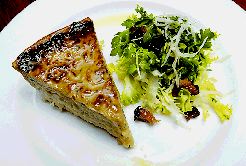
‘Eternally satisfying’ is the Alsatian onion tart pie at Pied-a-Tere. Photograph by : Ian Smith, Vancouver Sun
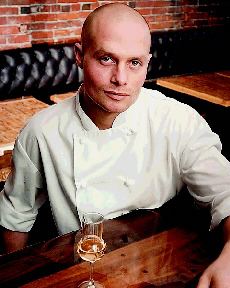
Nico Schuermans is owner/chef of Chambar Restaurant. Photograph by : Ian Lindsay, Vancouver Sun
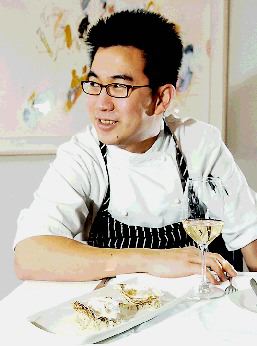
Angus An, chef at Gastropod Restaurant on West 4th Ave., with his oysters with horseradish snow dish. Photograph by : Mark van Manen, Vancouver Sun
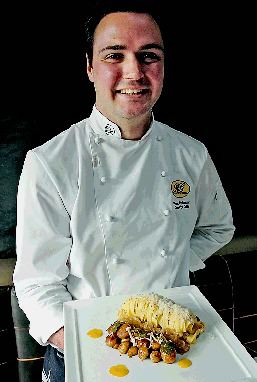
Raincity Grill’s Peter Robinson with famous Tagliatelli dish. Photograph by : Steve Bosch, Vancouver Sun
When you’re a professional Hoover (a restaurant critic) and one that lives in present tense more than in past (has a bad memory), then an occasional salute to delicious dishes eaten seems like the decent thing to do. Otherwise, all the talent, the care, the skill involved in preparing these fine dishes disappear into my river of forgetfulness. So many of my good food memories simply drown. I stick my head into the water and I see a tumbling blur and a few amazing dishes might bonk my memory.
Cooking, unlike other creative endeavours, comes to an unfortunate end. People eat what chefs create; they chew up their art; they digest it and well, you know the rest. There is no displaying of it in living rooms, let alone galleries; there is no listening to it, enraptured, over and over; there is no post-mortem discussion afterwards, like after viewing a Cohen brothers or Spike Lee or Godard movie. It is ephemeral, like theatre, but at least at a play the audience pays attention and it knows.
And with the open kitchens of today, chefs have to make nice even if customers are being ungrateful philistines. No more apoplectic yelling at their staff in displacement behaviour; no more making the line cooks cry; no more throwing pots at them like their mentors used to do to them.
Fulfilment for chefs is more of a metaphysical matter. It comes in knowing that people love their food and there’s pleasure in purely, simply feeding others. Anthony Bourdain might have broad-penned chefs into irresponsible, out-of-control, backroom fiends, but it so happens that the restaurant community, led by the chef, does more charity events than most, giving time, food or portions of their sales (the annual Dine Out Vancouver, Dine Out For Life) to causes. And besides, with all the open kitchens, even the bad boys and girls had to learn to behave better.
I decided it was time to showcase some of the memorable dishes I’ve had recently. The dishes that bobbed to the surface of my consciousness are telltale signs that I must have been in need of comfort and that the weather was still a bit chilly as my choices tended to be simple comfort dishes cooked exceptionally well (except for the Oysters with Horseradish Snow dish I had at Gastropod). Nevertheless, I think there’s something eternally satisfying about comfort dishes like Pied-a-Terre’s Onion Tart, Raincity Grill’s Tagliatelli with Onion Fondue and Mushroom Ragout, and Chambar’s Braised Lamb Shank with Honey and Figs that are memorable and leave their calling card. They’re my kind of soul food.
– – –
CHAMBAR’S BRAISED LAMB SHANK WITH HONEY, FIGS, CINNAMON
(Tajine D’aziz a L’agneau)
I can’t NOT have this when I visit Chambar, it’s so delicious. It’s best served with the classic couscous but it would go well with rice or fettucine noodles, too. Chef/owner Nico Shuermans say this is an all-seasons dish. “It’s really nice on hot days, too. It’s a dish from Morocco, right?” He prefers New Zealand lamb to Canadian for this dish because the shanks are generally smaller.
4 x 1 pound lamb shanks
2 onions finely sliced
2 cloves garlic, finely chopped
5 tablespoons honey
5 tablespoons olive oil
1 pinch of saffron
2 cinnamon sticks
2 teaspoons finely chopped ginger
3 tablespoons coriander seed
Salt, pepper
Water
1 bunch fresh cilantro
1 cup whole dried figs
Preheat oven to 400 degrees. Sear lamb shank to golden brown colour with olive oil and salt in saucepan. Place in deep roasting pan JUST large enough for 4 shanks. Add all ingredients around the shanks except for the cilantro and figs, fill pan with water to cover meat. Cover with lid or tinfoil. Roast for 4 hours.
Add figs, and fresh cilantro and let sit for 1 1/2 hours. Reheat before serving. let spices infuse.
Makes 4 servings.
PIED-A-TERRE’S ALSATIAN ONION PIE
Alsatian onion pie (or tart) is an ideal comfort food. The version at Le Crocodile in Vancouver is well known, but I recently found another at a more everyday kind of bistro, Pied-a-terre. Owner/chef Andrey Durbach says it’s something he can eat again and again when having lunch there (one of his three properties). “It’s comforting, familiar and most importantly, delicious. It’s one of those old classics that I never seem to lose my appetite for.”
Pate Brisée
1 1/4 cups all-purpose flour
1/4 teaspoon salt
1/2 cup butter, cold
1 egg, beaten
1 tablespoon cold water
Onion Filling
10 yellow onions, thinly sliced
1 cup butter, melted
4 egg yolks, beaten
2 tablespoons cornstarch
1 teaspoon minced fresh thyme
1/2 cup grated gruyere cheese
Salt and pepper to taste
1/4 teaspoon grated nutmeg
Pate Brisée: Place flour and salt in a mixing bowl and make a well. Cut butter into small pieces and put in well. Mix with fingers until a crumbly dough is formed. Add egg and water and knead until a ball is formed. Wrap in plastic and refrigerate for at least two hours or overnight. Roll out pastry on a floured surface to 1/8-inch thickness. Place in an 8 x 1.5-inch tart pan with removable bottom and prick dough with a fork. Blind bake pastry with pastry weights or beans for 15 minutes at 350 F.
Onion filling: Cook onions in butter gently over medium heat for 45 minutes in an 8-litre saucepan with a solid bottom. Drain cooked onions in a colander to remove excess moisture. Transfer to a mixing bowl and mix with all other ingredients. Pour into blind-baked pastry shell. Return to oven for 45 minutes to 1 hour until set firm and lightly browned. Leave for about an hour before cutting.
Makes 10 appetizers or 6 main courses.
GASTROPOD: OYSTERS WITH HORSERADISH SNOW
This is a standout dish at Gastropod. It requires timing and prep work. Use the freshest oysters possible, from a place like Lobster Man on Granville Island. For the “horseradish snow” chef/owner Angus An uses an inexpensive Tiger Brand ice shaver he purchased at Fujiya Japanese store on Clark Dr. I was told they won’t have any until summer so An suggested freezing the horseradish snow in a bowl, then “shaving” bits off the top with a spoon.
Horseradish snow:
2 cups milk
1/4 to 1/2 cup grated horseradish root, grated on microplane
1/4 cup yogurt
1 teaspoon salt, divided
1 tablespoon sugar
Juice of 1 medium lime
Shallot reduction:
5 shallots
1 cup rice vinegar
Sauternes jelly:
1 cup sauternes
2 1/2 — gelatin sheets (measuring 2″ x 4″)
2 dozen fresh, medium-sized Pacific oysters, like Golden Mantles
Horseradish snow: The ‘snow’ needs to be made a day ahead to freeze properly. In a saucepan, bring the milk to a low simmer. Remove the milk from the heat and grate the horseradish root into the milk, depending on the strength you desire,grate about 1/4 cup to 1/2 cup of grated horseradish into the milk. Bring the milk back to a simmer and turn off the heat to infuse the flavour. After about 30 minutes, the milk should be cooled. Stir in the yogurt, 1/2 teaspoon of salt, 1 tablespoon of sugar and the lime juice. The milk should taste subtley sweet with a hint of lime and the taste of horseradish should be prominent but not overpowering. Put into the container provided by the ice shaver and freeze over night. Or, if you don’t have an ice shaver, freeze in a bowl.
Shallot reduction: Finely mince the shallots and place in small saucepan. Cover with the rice vinegar and bring to a low simmer on the stove and then turn it down to the lowest possible setting. The slower the shallots cook, the better the finished product. It should take about 40 to 60 minutes. Cook until the shallots have absorbed the vinegar. When you tilt the pan, it shouldn’t have any residual vinegar left. Near the end, stir in 1/2 teaspoon of salt. Cool in the fridge.
Sauternes jelly: This needs to be made 2 hours before serving. Use a good quality sauternes. Soak the gelatin sheets in cold water until soft. In a pot bring sauternes to low simmer and whisk in the softened gelatin. Do not boil and make sure there are no gelatin lumps; strain if there are. Cool in the fridge until set. When ready, the jelly should be soft and look slurpable.
Oysters: When guests arrive, shuck the oysters and set them on crushed ice or coarse sea salt. When shucking oysters remember to use a proper oyster shucker and a dry towel to hold the oysters in place. Wrap the dry towel around the oyster with the flat end facing up. Insert the tip of the oyster knife through the back of the oyster, there should be a tiny hole where the two shells meet. Apply pressure without being too aggressive, otherwise you could break the shell or cut your hand. Once the knife penetrates the shells, move along the top shell until you cut the muscle that connects the two. Inspect the oyster, make sure it isn’t foul smelling and is free of broken shells and sand. On each oyster place 1/2 teaspoon of shallot reduction and 1 teaspoon of the sauternes jelly. With the ice shaver, shave the horseradish snow onto a bowl before your guests arrive. If you’ve frozen it in a bowl, shave the surface with a spoon. Place 1 to 2 tablespoons of snow on each oyster.
Makes 4 to 6 appetizer servings.
RAINCITY GRILL’S MUSHROOM TAGLIATELLI WITH ONION FONDUE
Patience. The results will be worth the time and effort. I loved the mix of the mushrooms, gorgeous onion fondue in a carbonara-like sauce in this dish. Use fresh mushrooms like oyster, chanterelle, shiitake, namenko, shimiji. Raincity Grill chef Peter Robertson says he’ll probably vary this dish by adding asparagus and broad beans as they come in season.
Handmade pasta:
1 1/4 cups all-purpose flour
9 egg yolks
Salt
3 tablespoons water
2 tablespoons olive oil
Mix together in a food processor to form loose, dry dough. Bring it together by hand until reasonably tight and knead for about 5 minutes. Let rest for a minimum of 1 hour and ideally, 2 hours. Cut into about three pieces then put through pasta machine starting at the widest setting and progressing to ever-finer settings. Roll through the second-finest setting (No. 2) twice and cut into tagliatelle noodles on the machine or by hand. Hang the pasta on a wooden pole or stick to dry, from 40 minutes to overnight, until completely dry.
Onion Fondue:
3 tablespoons unsalted butter
5 large yellow onions, finely sliced
1 teaspoon salt
2 teaspoons sherry vinegar
2 teaspoons fresh thyme leaves
In a large saute pan, 40 cm. across, melt the butter on a low heat then add the onions and salt, mixing to ensure the butter coats the onions.
Continue to cook the onions on a low temperature for between 21/2 to 3 hours, stirring occasionally making sure the onions do not take on any colour. This long cooking process brings out the natural sweetness of the onions. To finish add the vinegar, thyme and adjust the seasoning. Reserve.
Note: You will have more onion fondue than required for the pasta, however it is a great condiment to have on hand.
Mushroom ragout:
3 tablespoons unsalted butter
5 cups mixed mushrooms (cleaned, trimmed, cut)
2 tablespoons chardonnay
2 tablespoons veal demi glaze (available at Stock Market, Granville Island)
2 teaspoons thyme leaves
Salt to taste
In a large pan, melt the butter on medium heat and take to beurre noisette (nut brown). Add the mushrooms and cook out for 5 minutes. Deglaze with chardonnay then add the demi glaze. Cook out on a medium heat until the liquid has reduced and coats the mushrooms like a glaze. Add thyme, adjust seasoning and reserve.
The assembled dish:
Dried tagliatelli
2 teaspoons chopped fresh chives
2 teaspoons chopped parsley
2 teaspoons chopped chervil
2 tablespoons butter
1 cup parmesan, finely grated on micro-plane grater
3 egg yolks, beaten
Salt flakes to taste
In a pan of salted, simmering water (about 2 per cent salt content) cook the hand-made pasta for about 4 minutes.
Remove from water and transfer to a metal mixing bowl, add herbs, butter, cheese, egg yolks. Season each element with salt flakes as you go. Divide mushrooms and onions and place on 4 large bowels next to each other. Using the tines of a carving fork, twirl pasta into a cylinder beside the mushrooms and onions. Finish with some grated parmesan over the pasta.

